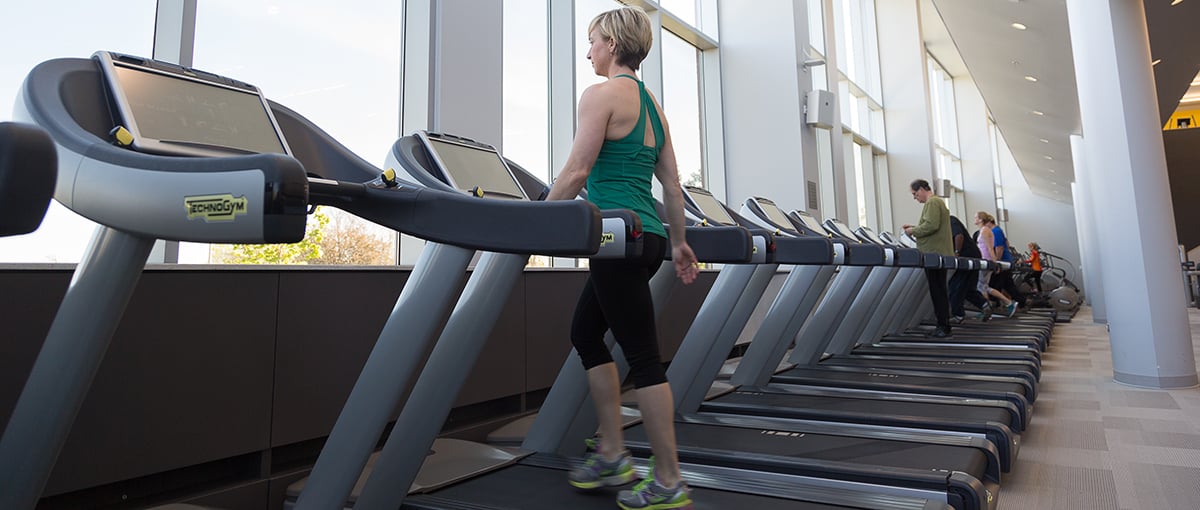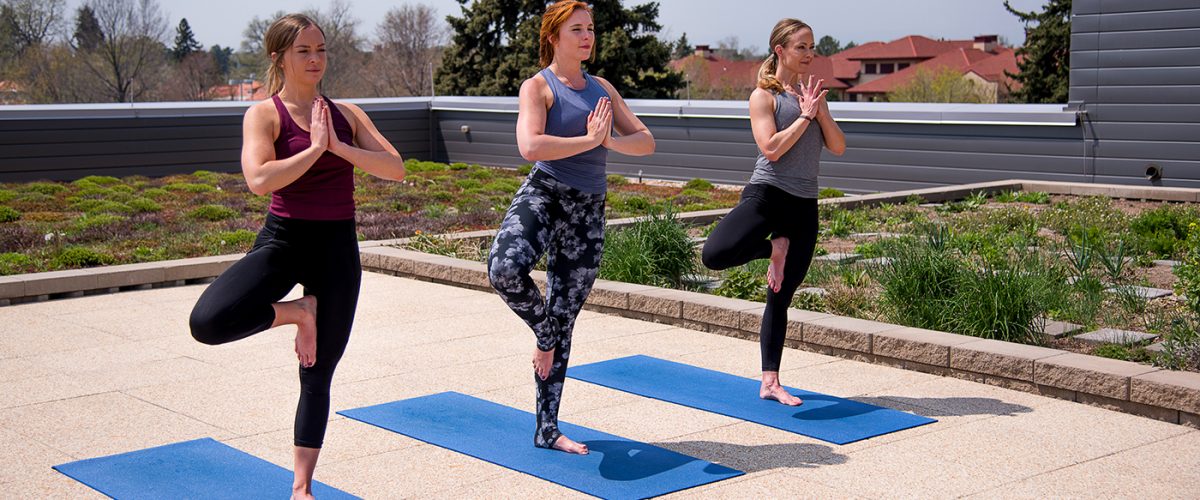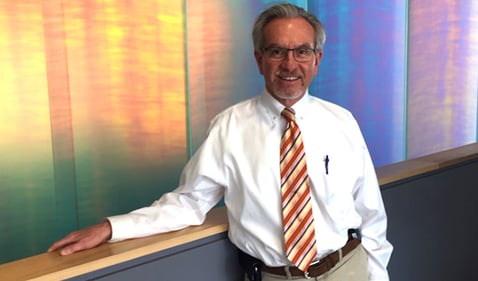Today’s fast-paced world tends to trigger angst and stress, leaving people in need of outlets that provide relief, tranquility and health. Dan Bessesen, MD, who was recently named director of the CU Anschutz Health and Wellness Center (AHWC), believes the center – a place of energy and wellness, connection and fun – can be a beacon of rejuvenation as well as community.
Bessesen, who served as interim director for two years, views the AHWC as a vital campus resource that incubates new multi-disciplinary strategies to promote health and wellness.
Dan Bessesen, MD, is the new director of the CU Anschutz Health and Wellness Center. He wants to make the center a vital campus resource.
“I think our center should be a place where people have a sense of community and of refuge. Our facility can cultivate a sense of being joyful and happy,” he said. “Visits here shouldn’t necessarily be about, ‘How many calories have I consumed and burned today?’ but rather ‘How can I enhance my day and my life in a positive way?’”
‘A sense of community’
Opened in spring 2012, the state-of-the-art AHWC was billed as a world-class model for healthy living. It featured high-tech fitness equipment, group and personal fitness programs, weight-management and nutrition programs, life counseling, massage, research labs and classes. The overarching mission was to change the nation and the world in terms of health and wellness.
The center’s core features and programs haven’t changed, but rather than looking to change the world, Bessesen mainly wants to meet the needs of the campus community – a small city unto itself. “This should be a place where all of our constituents – faculty, students, providers, researchers – can go and feel a sense of community,” he said.
Bessesen views the AHWC, where he’s worked as associate director and professor since the facility opened, as being a major resource that promotes well-being and togetherness. “The center can be where people go to reduce stress and feel healthy,” he said. “We can play a key role in that wellness process here on campus.”
When Bessesen talks about his personal and career interests, he often uses the word “balance.” He is fascinated by the interplay of physiology and the neurologic process. Appetite is a perfect intersection of the two, he said, with the brain sensing nutrient levels in the body and making behavioral decisions based on the information.
“Over time, it’s a precise balance,” he said. “The system works remarkably well. Most of us don’t think about it. We see cookies on the table and think, ‘I’ll go ahead and eat them.’ There’s very complicated biology taking place there.”
‘Blends my passions’
Bessesen graduated from the CU School of Medicine in 1982, before completing his internal medicine residency at the then-Denver General/Colorado General at 9th Avenue and Colorado Boulevard and then a chief residency in 1985.
He was an endocrinology fellow at the CU Health Sciences Center from 1987-90, then joined the medical team at Denver Health in 1991.
“This position really blends my passions,” said Bessesen, who is also the Anschutz Foundation Endowed Chair in Health and Wellness. “I’ve been involved with nutrition research here at CU since my fellowship, so I was involved with the development of this building.”
Wonderful facilities
And what a place the Gold LEED® Certified Building is. “I think most people who come into the building are struck by what a lovely place it is,” the director said. “They see the wonderful facilities and maybe think they’d like to start a membership. But they might also wonder: What’s going on in here?”
Trainers at the CU Anschutz Health and Wellness Center help members set up personalized exercise plans and offer guidance on meeting fitness goals.
Besides being a comprehensive fitness and wellness center, with the latest cardiovascular, weight-training and aquatic facilities, plus studios for an array of fitness/wellness classes, the AHWC offers:
- Expertise in physical activity and fitness. Trainers help members set up personalized exercise plans and offer specialized guidance on meeting fitness goals.
- A metabolic kitchen and demonstration kitchen. Experts help tailor personalize nutrition plans and provide guidance on meeting dietary and weight-loss management goals.
- A clinic where members receive expert guidance on lifestyle and wellness.
- Research space where investigators study nutrition, the health benefits of physical activity, the basic biology of appetite, and the pathophysiology and prevention of diabetes and cardiovascular disease.
‘Want to be of service’
Being located at one of the nation’s leading academic medical campuses gives the facility more service breadth than a typical fitness/wellness facility. For example, AHWC offers BfitBwell, a personalized exercise program for cancer survivors. The center also offers cooking classes and demonstrations for people with diabetes and other chronic health conditions.
The research enterprise is apparent throughout the center. For example, researchers often employ the center’s Technogym equipment which monitors each study participant’s workout regimen and biometrics. The center has a strong history in obesity- and weight-loss-related research, and nutritionists continue robust study into these areas.
 The CU Anschutz Health and Wellness Center offers an abundance of state-of-the-art fitness equipment.
The CU Anschutz Health and Wellness Center offers an abundance of state-of-the-art fitness equipment.
For the large staff contingent on campus, including at partner hospitals, the AHWC is expanding its programs to enhance employee wellness. For example, the center collaborates with nurses at University of Colorado Hospital to enhance their resiliency and stress reduction. “They’re driving the bus on the project,” Bessesen said. “We’ve told them what we can provide – such as stress-reduction and mindfulness exercises – but they’re giving us feedback about what they’re looking for. We want to be of service like that to other employee groups on campus.”
The AHWC also wants to increase services for primary care health providers. With its range of service offerings – including multiple weight-loss programs, psychological counseling, fitness training and disease-specific exercise and nutrition programs – the center collaborates with physicians in tailoring diets to a patient’s specific needs.
The center’s increased campus-constituency focus is also apparent with new flexible membership options and increased outreach sessions, such as healthy cooking demonstrations for students.
New direction
Student groups from area junior high and high schools often tour the facility and learn about how nutrition, physical activity and mindfulness can improve health.
Meanwhile, the AHWC is assembling a cross-sectional advisory board of both AHWC advocates as well as representatives of various campus constituencies. The idea is to respond to advocate needs while creating sustainable services and partnerships.
Bessesen recognizes there are endless possibilities on a campus filled with creative and driven people from all walks of life.
“We’ll turn our focus to where we see partnerships, energy, movement and sustainability,” he said. “There are some people who may think this new direction is not what the center has been in the past, but it definitely represents what our campus and community want now.”



.png)

